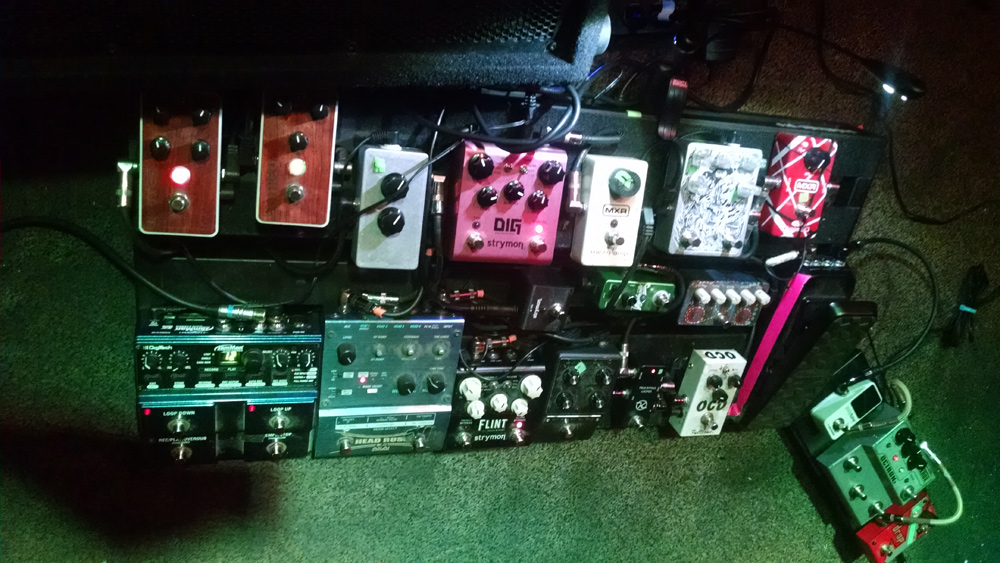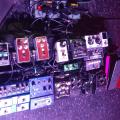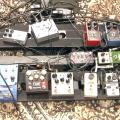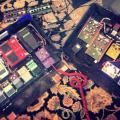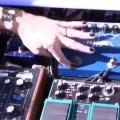Back in August 2016 I had a chance to see one of my favorite bands – Russian Circles. For those of you not familiar with this band, they are a 3 piece instrumental band, but definitely on the heavier side of things. They have complex and rich sonic textures with the ability of moving the audience with music only. They are based out of Chicago, IL and members are Brian Cook (bass), Dave Turncrantz (drums) and Mike Sullivan on guitar. Definitely, check these guys out! Starting in April, the Russian Circles will be touring the US again – but with Eagles of Death Metal and Mastodon. Killer tour, so keep your eyes out for that!
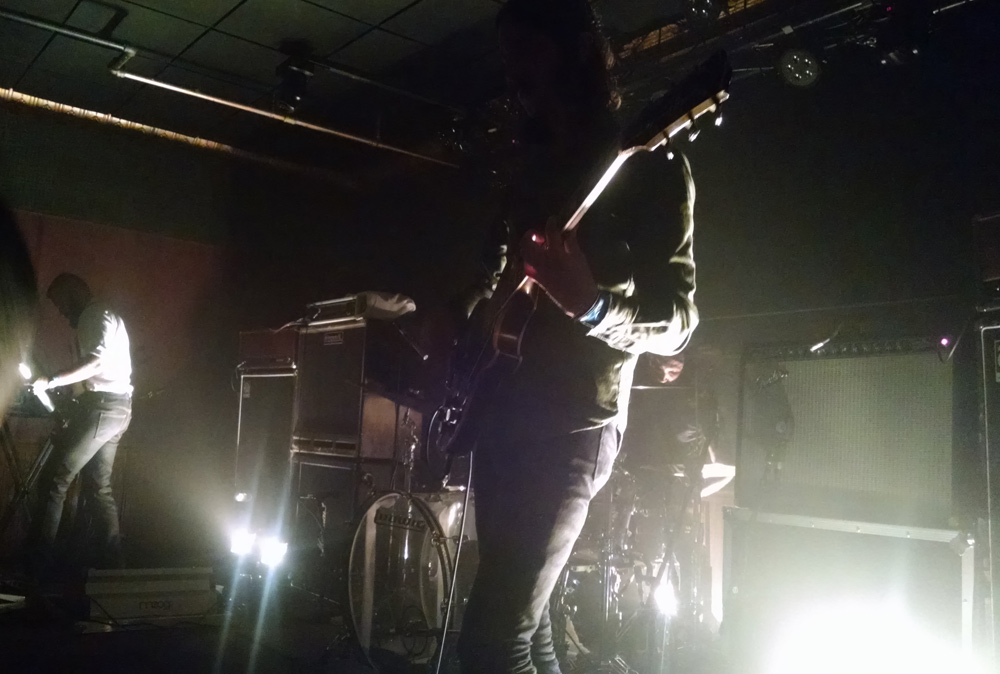 Even though I’ve been a fan for years, the 2016 show was the first time I had a chance to see them live. Knowing the recorded songs, I was extremely curious on how the band works to accomplish them live, especially with Mike’s heavily layered guitars and looped pieces. That night I positioned myself right up to the stage where I can watch and to attempt to deconstruct how Mike Sullivan pulls some of these off.
Even though I’ve been a fan for years, the 2016 show was the first time I had a chance to see them live. Knowing the recorded songs, I was extremely curious on how the band works to accomplish them live, especially with Mike’s heavily layered guitars and looped pieces. That night I positioned myself right up to the stage where I can watch and to attempt to deconstruct how Mike Sullivan pulls some of these off.
Now, I’ve seen plenty of guitarists with impressive boards do their thing. But I’ve never seen a musician work the board like Mike Sullivan. Honestly, it was inspiring to see him not only manipulate the signal from the guitar, but also manipulate the output by controlling amps and the signal going out. I really felt the pedalboard was an instrument as well.
After the show I was able to talk to Mike and he was very cool and friendly – and patient with my gear related questions. Before I called it a night I asked he would be up for doing an interview after I processed the show and gear.
Before we get into the interview, let’s take a look at the pedalboards first, so you’re
Big Board
Dunlop Volume Pedal
Fulltone OCD
Keeley True Bypass Looper
Moog Minifooger MF Delay
Strymon Flint
Akai Head Rush E2
Digitech Jamman
Zvex Fuzz Factory
Outlaw Effects Vigilante Chorus
Strymon Favorite Switch (for Strymon DIG)
MXR EVH90 Phase 90
Abominable Electronics Throne Torcher (HM-2 Clone)
MXR Micro Amp
Strymon DIG
Unknown 2 knob pedal
Bogner Wessex Overdrive
Bogner Bunley Distortion
Small Board
Digitech Drop
Foxrox Electronics Octron
TC Electronics Polytune Mini
Talking with Mike Sullivan
Can you talk about the amp configuration? Looks like you’re running a Fender Twin and the Verellen Meat Smoke. Are they both always on? And how are they ‘joined’?
Yes, recently I’ve been running three amps. On stage left I’m playing a Fender Twin and Verellen Meat Smoke through an Ampeg 8×10. On stage right, i have another Twin running, which is EQ’ed brighter. I use a Lehle 1at3 switcher to connect all of the amps. All amps are always on.
Are you using the volume pedal to control signal to one of the amps? I noticed it would be pulled all the way back (off) and you were still playing? Can you go into detail?
The volume pedal is at the front of the effects chain and affects the entire guitar signal. As far as when the pedals is bulled back all the way, I inserted some tape at the heel of the pedal, so when I pull the volume all the way back, the signal isn’t completely cut; its just significantly quieter.
The Akai Headrush is a great looper pedal with the feature of splitting signal / loops to multiple outs/amps. Is that configured to send loops to individual amps?
The only signal splitting i utilize is to send the loop signal and live signal to a two channel mixer so I can have further control over the volume of each. This is to compensate for the slight volume loss of the loop level that inherently occurs with the Headrush.
I was surprised when you would use the looper. I noticed it on the obvious rhythm with signal lines on top, but it appears that some time you were doing quick doubling on parts. What’s you’re philosophy when it comes to looping? What are you trying to achieve/gain?
Occasionally I’ll double parts, similar to overdubbing in a studio. For example, at the end of the song Mladek, I loop a signal note chug pattern and then add a higher finger tapped melody on top. Often I’ll keep looping the melody until its audible over the chugs.
I’m guessing the Digitech Jamman is used for segues between songs. I noticed that it had a single line out on the unit. Does that run to a DI or do you route that through the amps? From my position, it was hard to tell where I was hearing the segue music/sounds – from FOH or from the amps.
Yes, i primary use the Jamman for playing pre-recorded drones, which i usually mix with a live loop form the Headrush to make the segues more interesting and slightly different each night. All of the signal is running through the guitar signal: nothing is exclusively going to FOH. I don’t use the single line out of the pedal; its plugged in with a conventional 1 input, 1output. No funny business.
In the past, I’ve seen the Electro-Harmonix Holy Grail after the JamMan on your board. Are you still using that Holy Grail with the JamMan? I noticed something on top of the amp that looked like a possible EHX nano enclosure, but couldn’t verify.
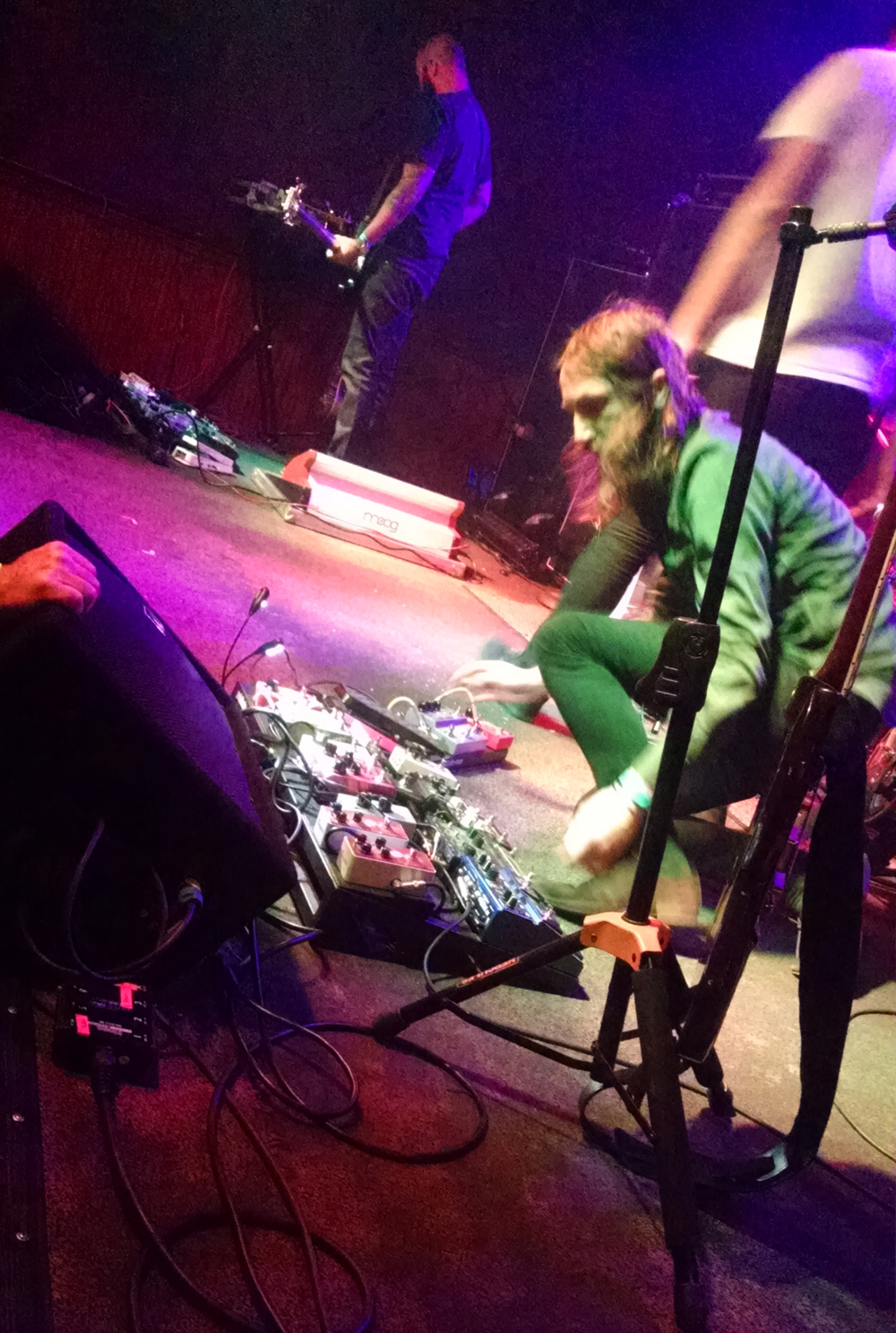 The Holy Grail was placed very last in the effects chain to add a bit of reverb to the overall signal. Now that I’m running amps with proper reverb, I no longer use the Holy Grail. The other small pedal you described is actually the two-channel mixer. The two knobs adjust the live signal and the Headrush loop level.
The Holy Grail was placed very last in the effects chain to add a bit of reverb to the overall signal. Now that I’m running amps with proper reverb, I no longer use the Holy Grail. The other small pedal you described is actually the two-channel mixer. The two knobs adjust the live signal and the Headrush loop level.
Also worth noting, as much as i enjoy the tone of the Moog delay, I’ve swapped that out for a Source Audio Nemesis delay. That’s a really great pedal. Endless delay options with a good amount of programmable presets. This pedal has really made things quite easier for me. Its convenient for pulling up delays for various tempos and delay types. I’m just scratching the surface of the potential of the pedal. You can dial in some pretty far out and compelling sounds.
During your performance I noticed that you adjusted various settings on the Strymon DIG. Do you have multiple settings / song? Or are you adjusting for the feel of the moment?
I do have multiple settings for various songs. Recently I’ve been taking advantage of the auxiliary tap/favorite pedal that can be plugged into the pedal. This allows you to switch back and forth from a “favorite saved setting†and the current settings of the pedal. The dig is really cool pedal that can play multiple delays patterns simultaneously. I’ll often add a dotted eight note delay with a regular quarter note delay, which are automatically synced up with the tap tempo.
With the Digitech Drop it appears that you have that set for 2nd semitone. What is your philosophy with using this pedal?
I use that pedal for various applications. Mainly, I use the 2nd semitone as a substitute for using another guitar tuned a whole step lower. Some songs use the that same function for adjusting the pitch of riffs that use open strings: i repeat a pattern on guitar and engage the pedal halfway through and it alters the progression. Another setting that I’m fond of is the setting that plays octave down with the dry signal. This can be heard on the arpeggio guitar line on the first part of the song Mota.
In between songs when the Jamman is activated, I noticed that you switch the Keeley True Bypass looper on. It appears that the signal is muted at this point. How are you using that bypass looper?
The True Bypass looper is simply for turning turning on/off the Bogner pedals. I typically run both the Wessex overdrive and Burnely distortion in conjunction. The looper allows me to conveniently turn on both pedals at once.
Like I mentioned earlier, I’ve done a few write ups on the boards. Just like so many musicians, pedals come on and off as needs require, or if they get bored, etc. I noticed the following changes from 2015 to your recent show…
Added Foxrox Electronic Octron pedal in 2016
Changed Moog Minifooger MF Boost to Fulltone OCD in 2016
Changed Death by Audio Fuzz War to Throne Torcher (HM-2 Clone) in 2016
Changed Strymon El Capistan to Strymon DIG in 2016
Added unknown 2 knob pedal from Akai in 2016
Added MXR EVH 90 Phase 90 in 2016
Can you explain what prompted some of these changes? I’m only asking for possible insight on those decisions. I might not include this in the write up.
Sure. I used the Octron frequently while recording our last record Guidance. Its nice for fattening up songs like Lisboa and Mota. I swapped out the MF boost for the OCD because I wanted a little more gain out of the boost. However, I’ve recently swapped out the OCD for an Xotic AC pre-amp boost because it seems to have more clarity. The Throne Torcher is a cool HM-2 clone that was used on several songs on Guidance. That replaced the Fuzz War because no songs really featured the Fuzz War, despite it being one of my favorite fuzz pedals. I’m sure the Fuzz War will make its return eventually.
Okay.. now I’m going to switch gears a little bit…
Looking back at your career and the growth of Russian Circles – can you take us back to some of those early ‘band’ milestones? From the days of playing the first show to the days of driving in a shitty van on your first tour to the point of playing a professional level with road help and good gear. These are all milestones that can seem like epic leaps for bands in whatever current state they’re in. I think getting your point of view would be really interesting!
Thankfully, its been a very gradual experience. We’ve been a band for 12+ years and nothing really happened overnight. As far as playing live, the feeling and energy hasn’t really changed at all. The excitement of our first show in a basement is similar to playing bigger shows. Both then and now, the set feels immediate and engaging. We always try our hardest serve the set and help it connect with the crowd. This has been augmented with the luxury of affording a live sound engineer and lighting designer.
We’ve never been a band that’s been comfortable traveling in buses or spending much on transportation. We’re still a van and trailer touring band. We enjoy small luxuries like fewer people per hotel room, enjoying a good meal on off days and as of last August, we have Air Conditioning for the first time. We had AC for 4 days in 2010 but that van got totaled in an accident. Its sadly evident that we prioritize gear over our tour van. Europe is a different story. Europe is a cozy operation thanks to a rental van and driver to help make things smoother. Even this has changed very little though. We’ve had the same European driver/tour manager since 2007, each time in a Sprinter van. When we find people we really like, we keep working together as long as possible.
On the road, have you ever had persistent gear gremlins that cause havoc on past or present tours?
Oh man…of course. Where to begin? We keep our gear in decent shape but some things are just inevitable. UK power always haunts me. What bothers me most are recurring or one-off problems that you can’t diagnose. One show in Glasgow a few years ago comes to mind. We did two shows in one night. Soundcheck and the first show were smooth sailing. But for some unknown reason, when ever I grabbed my guitar for line check before the second show, I would persistently get electrocuted each time I touched my guitar. It was painful, confusing and humorous at the same time. Anybody else in the room: band members, crew, even an audience member could touch my guitar with out any issue, but the second they’d touch me, they’d get a very strong jolt. At the time, I had a metal plate and 7 screws in my leg, which obviously was part of the reason but we couldn’t figure how to get around the problem. My right arm was burning with pain and playing was not even close to possible. We finally solved the problem by folding a drum carpet up several times over and then I was able to stand on that with out conducting the electricity. I have zero clue what was shaking that night.
What are the most difficult challenges when on the road? And how do you deal with them?
The biggest aspect for me is to cope with the lack of privacy and being around hundreds of people all the time. I enjoy going for long walks around town. I’m an old man inside. I really love trekking around, usually by myself.
Flying is usually a pain in the ass. Avoiding overages, dealing with dummies, airlines temporarily losing gear…
American tours sometimes feel like groundhog day. Its good to mix things up. Play new venues, visit National Parks whenever possible. We plan more days off to avoid exhaustion and to make sure tour is more than just sitting in a van all day or waiting around backstage. Each tour is its own beast. Good things and bad things are inevitable. Just stay calm and role with the punches.
You have quite a lot of pedals on your board and all are quite vital for making the Russian Circles sound. Do you have back up pedals in case things break? I only ask this, since some of the pedals are boutique and might be hard to find depending on your location. Have you ever had to deal with this?
We travel with a few backups. Between Brian and I, we usually have several backup loopers, delays, gain pedals and an amp or two. A lot of my pedal choice is based on reliability. If a pedal is notorious for breaking, its not worth bringing on the road.
What’s your favorite Van Halen song? (for the readers out there not familiar.. Mike is a big VH fan)
Tough question! Unchained is probably my favorite but the whole 1984 album is what really gets with me. Its a very sentimental album for me. That was the beginning of the end for me. That album is attached to my earliest memories.
I wanted to get nerdy with these questions, so I was happy to see that Mike was open to answering them. Thanks so much Mike. Let me know what you guys think by commenting below. Love to hear your thoughts!

